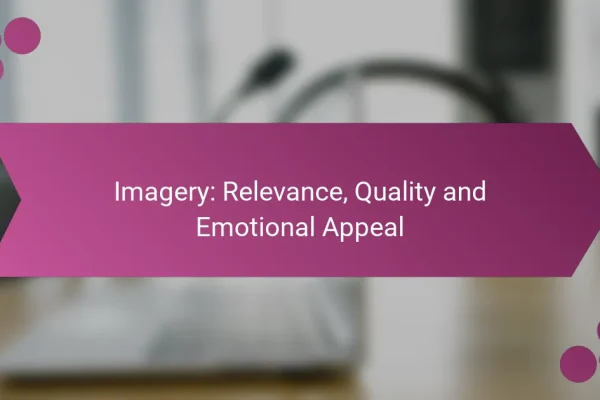What are effective display advertising creative design elements in Ireland?
Effective display advertising creative design elements in Ireland include visual hierarchy, color psychology, typography choices, imagery and graphics, and call-to-action placement. These elements work together to capture attention, convey messages, and drive user engagement.
Visual hierarchy
Visual hierarchy refers to the arrangement of elements in a way that guides the viewer’s eye and emphasizes the most important information. Use size, contrast, and placement to create a clear path for the audience, ensuring that key messages stand out. For instance, larger fonts or bold colors can draw attention to headlines or offers.
Consider the flow of information; a well-structured layout can lead viewers from one element to the next seamlessly. Avoid clutter, as too many competing elements can confuse the audience and dilute the message.
Color psychology
Color psychology plays a crucial role in influencing emotions and behaviors. Different colors evoke different feelings; for example, blue can convey trust, while red may create urgency. When designing display ads, choose colors that align with your brand identity and the desired emotional response from your audience.
In Ireland, consider cultural associations with colors. For instance, green is often linked to Ireland’s identity and can evoke feelings of growth and harmony. Use color strategically to enhance your message and encourage user interaction.
Typography choices
Typography choices significantly impact readability and brand perception. Select fonts that are easy to read and reflect your brand’s personality. Sans-serif fonts are often preferred for digital ads due to their clarity on screens.
Limit the number of different fonts to maintain a cohesive look. A common practice is to use one font for headlines and another for body text. Ensure that font sizes are appropriate for visibility, especially on smaller screens.
Imagery and graphics
Imagery and graphics should complement the overall message and enhance visual appeal. High-quality images can capture attention and convey messages quickly. Use relevant visuals that resonate with your target audience and reflect your brand values.
Consider using local imagery that reflects Irish culture or landscapes, as this can create a stronger connection with the audience. Avoid stock images that feel generic; authentic visuals can significantly improve engagement rates.
Call-to-action placement
Call-to-action (CTA) placement is critical for driving conversions. Position CTAs where they are easily visible, such as at the end of the ad or in the center of the design. Use contrasting colors to make CTAs stand out from the rest of the content.
Be clear and concise with your CTA text. Phrases like “Shop Now” or “Learn More” can effectively prompt users to take action. Test different placements and wording to determine what resonates best with your audience in Ireland.
How can I optimize display ads for better engagement?
To optimize display ads for better engagement, focus on testing different creative elements and personalizing content to resonate with your audience. Employing strategies like A/B testing, dynamic content, and user-generated content can significantly enhance the effectiveness of your ads.
A/B testing design variations
A/B testing involves creating two or more variations of an ad to determine which performs better. By changing elements such as images, headlines, or calls to action, you can gather data on user preferences and engagement rates.
When conducting A/B tests, ensure that you have a clear hypothesis and a sufficient sample size to achieve statistically significant results. Aim for a test duration of at least one to two weeks to account for variations in user behavior.
Using dynamic content
Dynamic content allows you to tailor ads based on user data, such as location, browsing history, or demographics. This personalization can lead to higher engagement rates as users see content that is more relevant to their interests.
Implementing dynamic content requires a robust data management system and an understanding of your audience. For example, a travel ad could showcase different destinations based on the user’s location, increasing the likelihood of interaction.
Incorporating user-generated content
User-generated content (UGC) can enhance the authenticity of your display ads. By featuring reviews, testimonials, or images shared by customers, you can build trust and encourage engagement.
To effectively use UGC, curate high-quality submissions and ensure they align with your brand’s message. Consider running campaigns that encourage customers to share their experiences, which can then be highlighted in your ads.
What are the best practices for display advertising design?
The best practices for display advertising design focus on creating visually appealing and effective ads that capture attention and drive engagement. Key elements include responsive design, appropriate ad formats, and maintaining brand consistency.
Responsive design techniques
Responsive design techniques ensure that display ads look good on various devices, including desktops, tablets, and smartphones. This involves using flexible layouts, scalable images, and CSS media queries to adapt the ad’s appearance based on screen size.
To implement responsive design, consider using vector graphics that maintain quality at different resolutions. Additionally, test your ads on multiple devices to ensure that key messages and calls to action remain clear and accessible.
Ad format selection
Selecting the right ad format is crucial for maximizing visibility and engagement. Common formats include banner ads, interstitials, and video ads, each serving different purposes and audience preferences.
When choosing an ad format, consider the platform where the ad will be displayed and the target audience’s behavior. For example, video ads may perform better on social media platforms, while static banners might be more effective on news websites.
Brand consistency
Maintaining brand consistency across display ads helps build recognition and trust with your audience. This includes using consistent colors, fonts, and messaging that align with your overall brand identity.
To ensure brand consistency, create a style guide that outlines your brand’s visual elements and tone of voice. Regularly review your ads to confirm they adhere to these guidelines, which can enhance brand recall and improve campaign effectiveness.
What tools can help in creating display ad designs?
Several tools can significantly enhance the process of creating display ad designs, each catering to different needs and skill levels. Popular options include Adobe Creative Cloud, Canva, and Figma, which offer various features for design, collaboration, and quick edits.
Adobe Creative Cloud
Adobe Creative Cloud is a comprehensive suite of design tools that includes Photoshop, Illustrator, and InDesign, making it ideal for professional designers. These applications provide advanced features for image editing, vector graphics, and layout design, allowing for high-quality, customized display ads.
When using Adobe Creative Cloud, consider the learning curve associated with its tools. Beginners may find the software complex, so investing time in tutorials or online courses can be beneficial. Additionally, Adobe offers subscription plans, which can range from monthly fees to annual commitments, depending on the tools you need.
Canva for quick designs
Canva is a user-friendly graphic design tool that enables quick creation of display ads with its drag-and-drop interface. It offers a wide variety of templates, images, and fonts, making it accessible for those without extensive design experience.
For effective use of Canva, take advantage of its pre-designed templates tailored for different platforms and sizes. This can save time and ensure your ads meet specific requirements. However, be cautious of overusing templates, as this can lead to generic designs that may not stand out.
Figma for collaboration
Figma is a cloud-based design tool that excels in collaboration, allowing multiple users to work on display ad designs simultaneously. This feature is particularly useful for teams, as it facilitates real-time feedback and edits.
To maximize Figma’s collaborative capabilities, establish clear roles and guidelines for team members. Utilize its commenting feature to streamline communication during the design process. Keep in mind that while Figma offers a free version, advanced features may require a paid subscription, which can be a consideration for budget-conscious teams.
What metrics should I track for display ad performance?
To effectively evaluate display ad performance, focus on key metrics such as click-through rates and conversion rates. These metrics provide insights into how well your ads engage users and drive desired actions.
Click-through rates
Click-through rate (CTR) measures the percentage of users who click on your ad compared to the total number of impressions. A higher CTR indicates that your ad is compelling and relevant to your audience. Generally, a good CTR for display ads ranges from 0.5% to 2%.
To improve your CTR, consider A/B testing different ad creatives, headlines, and calls to action. Avoid overly complex designs that may distract users from the main message. Instead, aim for clear visuals and concise text that resonate with your target audience.
Conversion rates
Conversion rate refers to the percentage of users who take a desired action after clicking on your ad, such as making a purchase or signing up for a newsletter. This metric is crucial for assessing the effectiveness of your ad in driving actual business outcomes. Typical conversion rates for display ads can vary widely, often falling between 1% and 5%.
To enhance conversion rates, ensure that your landing pages are optimized for user experience and aligned with your ad messaging. Use strong calls to action and minimize distractions on the landing page. Regularly analyze user behavior to identify potential barriers to conversion and make necessary adjustments.











